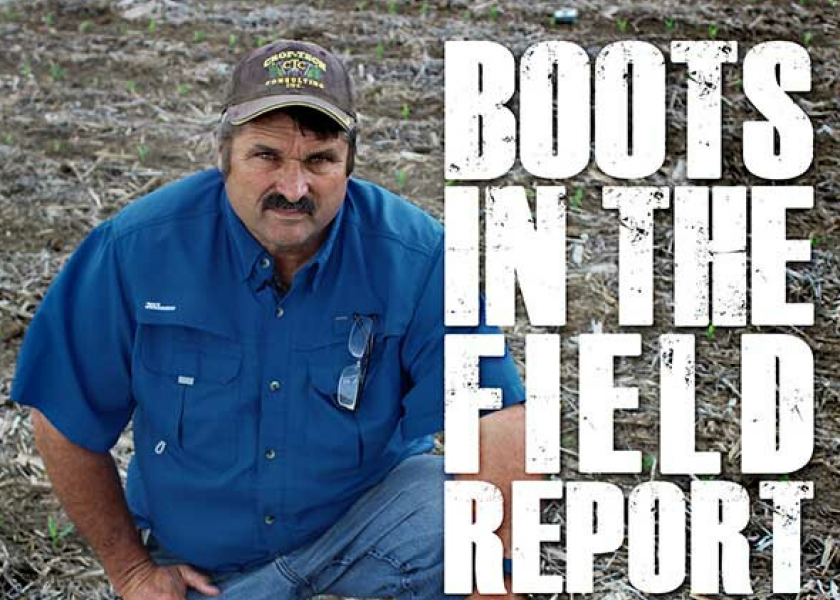Ferrie: You Can Reduce Fertilizer and Still Harvest Big Corn Yields, But Some Parameters Apply

While winter weather conditions are in full tilt in some parts of the country, Ken Ferrie and his team are actively working with farmers to finalize their agronomic plans for the 2023 cropping season.
As part of their efforts, Ferrie and team are offering a virtual Corn and Soybean College this Thursday, January 5. The day-long, live event features agronomic sessions led by Ferrie, Isaac Ferrie and Matt Duesterhaus.
“There will be live question and answer segments throughout the event, and we welcome your questions during the program,” says Ferrie, Farm Journal Field Agronomist.
You can learn more about the program at www.croptechinc.com. Look for “Virtual Winter College” at the top of the home page.
In a recent Boots In The Field podcast, Ferrie addresses what he says has become a common question in recent weeks.
Question: “Farmers are asking if they can pick up enough efficiency by using starter on the planter or strip-tilled fertilizer in a band, could they reduce the overall amount of fertilizer used? In this time of high prices, can they cut back on overall fertility, waiting for those prices to go back down?”
Answer: Ferrie says the answer is a conditional yes. He offers the following detailed explanation, as a for instance.
“Five gallons of 10-34-0 and zinc with the planter will outyield 200 pounds of broadcasted DAP, which means that 20 pounds of phosphate as starter has more horsepower than 92 pounds of phosphate in broadcast. This horsepower is coming from the right place at the right time (the 4Rs) early in the season when the plant needs it, when you're trying to give it as big a push as you can.
“While this looks like we could get by with less fertilizer in the band, especially short term, it doesn't tell the whole story. Phosphate applications are as much about feeding the soil biology as they are about feeding the plant. Soils low in phosphorus tend to not only (cause) a problem for the crop, but they have low energy for the microbes in the soil. When you applied only 20 pounds of phosphate as starter, and let's say you harvest 250-bushel corn, and where you broadcast 200 pounds of DAP you only produce 240-bushel corn, it would seem the extra P wasn't worth it. But we need to follow the math all the way out.
“The 250-bushel corn removed 90 pounds of phosphate, and you only applied 20, so you lowered your soil reserves overall by 70 pounds. Now where you put the 200 pounds of DAP that 240-bushel corn removes 85 pounds of phosphorus. So the 90 pounds of phosphorus that's coming in the DAP application will hold your P levels.
The Numbers Have To Add Up -- At Some Point
“Think of it this way. Every truckload of grain that leaves your farm is fertilizer going down the road. With 1,000 bushels of corn that's 350 pounds of phosphate and 250 pounds of potash. For 1,000 bushels of beans that's 750 pounds of phosphate and 1,150 pounds of K that's leaving your farm. There's no magic dust or 4R treatment that's going to change these numbers. So, while you may be able to rob from Peter to pay Paul with the efficiencies from banding, it doesn't change the math in the end,” Ferrie says.
He offers this additional analogy. “We know if we keep our truck engine tuned, keep our tires inflated to the right inflation and drive 55 miles an hour instead of 75 miles an hour, we'll get better gas mileage. But if you drive far enough, you're still going to run out of gas. Many farmers could use the efficiency of 4R management to temporarily pull back on their fertilizer inputs without seeing a yield drop. When you're soil testing every two years, you can see when that tank is getting close to empty – that point when levels must be replenished or you're going to start to see yield losses.
“When growers ask this question but don't have a recent soil test, it's a little bit like Russian roulette. If the farm has been drained of fertility, banding and placing nutrients close to the plant will help. But remember, one of the 4Rs is the right rate. Keep your farm in good shape fertility wise, and it will allow you to step on the brakes when you need to to get markets back in line. Doing this with added efficiency of banding your fertility and using a soil test to guide you -- like a fuel light in your truck -- it will work. But eventually the math must work. Don't be fooled by one year's results,” Ferrie says.
To hear Ferrie share his perspective on the topic of reducing fertilizer, listen to the podcast here:







